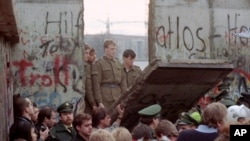Thirty years ago today, the Berlin Wall was torn down. For 28 years, this most visible manifestation of the Cold War and a symbol of the tug of war between Communism and Capitalism, the two prevailing ideologies of the second half of the twentieth century, cut through the heart of one of Europe’s great cities.
But it was far more than just a symbol to the German people on both sides of the divide—it was physical proof that the country would never be whole again.
After World War II ended in 1945, the four nations that were instrumental in defeating Nazi Germany: the United States, France, the United Kingdom and the Soviet Union, split the country into four administrative sectors. In the 16 years after the Second World War, some 2.5 million of East Germany’s best educated people and skilled workers, most of them young, crossed permanently to the West.
So, to stop the brain drain, in the early hours of Sunday, August 13th, 1961, the East German police and units of the East German army closed the border separating the Russian sector from the other three. They tore up streets running along the eastern side of the border to make them impassable to vehicles, and installed barbed wire coils and fences around the three sectors that comprised West Berlin, as well as along the 43 kilometers which split the city and its population in half. Over time, they would replace the wire with a concrete wall 3.6 meters high and 1.2 meters wide.
Almost immediately, attempts to cross the wall to the West began. Some 5000 tried. Around 200 died in the attempt.
Finally, in 1989, Communist governments collapsed across Eastern Europe, and on November 9, under pressure from its restive population, the East German government partially opened the border in Berlin. A flood of East Germans rushed to West Berlin, and following celebrations up and down its length, they began to tear down the Berlin Wall. At zero hour Central European Time, October 3rd, 1990, Germany once again became one country. The German family was reunited.
And the crumbling of the Berlin Wall started an avalanche that saw the liberation of millions of people across Eastern Europe.














